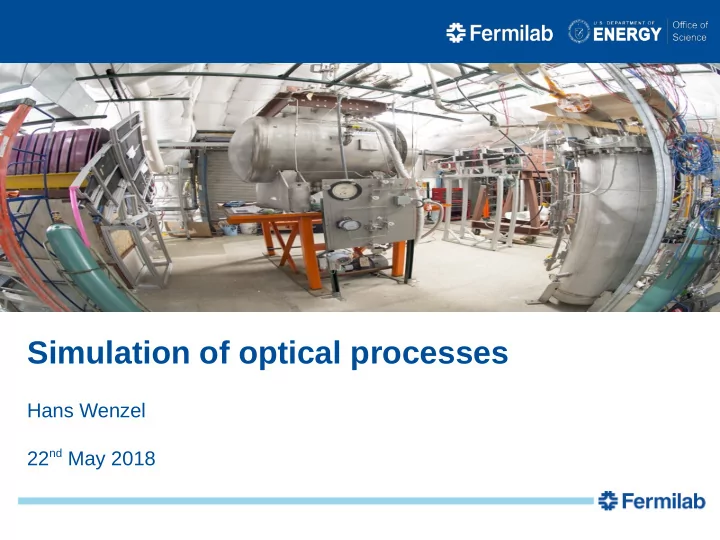

Simulation of optical processes Hans Wenzel 22 nd May 2018
Outline Three modes to run optical simulation Optical processes in Geant 4 Liquid Argon TPC’s: ● Refraction index and propagation speed ● Rayleigh scattering: effect on timing and imaging ● Absorption length
Three modes to run optical simulation. Geant4 Simulation 1. Standard way: SimEnergyDeposit e.g. nest take account correlations Optical photons electrons Photon detector LUT Drift to wire etc. 2. Full simulation: 3. Obtaining LUT: Enable optical processes and propagation in Full Geant4 simulation Geant4→ check LUT. currently done in a separate (very CPU expensive (>1000X) but might be program (LightSim) → no replaced specialized ray tracers running on GPU’s reason not to integrate in (OPTIX) geant4 optical processes have been implemented by Simon Bly) LArSoft
Optical processes in Geant4 Production: Boundary Process: Total internal reflection etc. at boundaries ● Cerenkov Process between materials with different refraction index. ● Scintillation Process ● WLS ● Transition Radiation Surface Process: Stepping: e.g. reflection on metallic surface needs ● Absorption Surface properties. ● Rayleigh scattering ● Mie Scattering
Optical physics in Geant 4 In Geant4, the optical physics has an exceptional position among the physics processes: it adds: ● special particles (optical photons). The only particle that can be reflected or refracted at optical surfaces, ● only particle created in optical processes like scintillation, Cherenkov radiation, and wavelength- ● shifting (WLS). G4OpticalPhoton differs from the “usual” high-energy particle-physics photon (G4Gamma) in Geant4. ● ● new properties for materials and optical surfaces. Optical properties need to be assigned to the materials whenever optical physics processes are to be considered in the simulation. Every material needs at least a refractive index spectrum (which corresponds to the dispersion relation) and an attenuation length spectrum, though the attenuation length is by default set to infinity if it is not defined. Special optical materials, i.e. scintillating and WLS materials, additionally require the specification of the emission spectra as well as of the rise and decay times. More properties can be assigned to optical surfaces between volumes, e.g. the reflectivity of the surface. arXiv:1612.05162 Peculiarities in the Simulation of Optical Physics with Geant4
Refraction index and propagation speed ArXiv:1502.04213 root [0] .L LAr.C++ group velocity is equal to the phase velocity root [1] init(); // initialize vp=c/n only when the refractive index is a constant root [2] sellmeierLAr(); root [3] rindextable(); <matrix name="RINDEX" coldim="2" values="1.7712*eV 1.23148 1.78626*eV 1.23154 1.80157*eV 1.2316 1.81715*eV 1.23166 ..... 10.6975*eV 1.72744"/> n = c/vp = ck/ω.
Rayleigh scattering root [0] .L LAr.C++ root [1] init(); root [2] rayleigh(); root [3] rayleightable() ArXiv:1502.04213
Rayleigh scattering 100 10 Length: 1m Radius 0.5m 1000
Rayleigh scattering: effect on timing and imaging 10000 incident photons No scitillation time constant involved.
Absorption length arxiv:1611.02481: 52.7 cm arxiv:1502.04213: 60 +/- 6 cm 55 +/- 5cm µ boone specs.
Recommend
More recommend